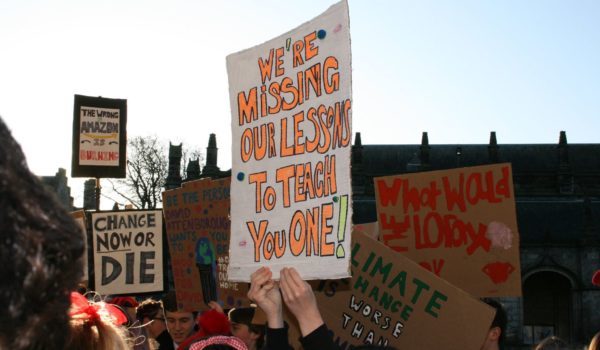Fast fashion is a massive worldwide industry, dominating its sector both in terms of production and sales values. “Fast Fashion” can be defined as the production and marketing of very cheap clothing and in vast amounts. These clothes are often of poor quality, in some cases close to a wear once and throw away scenario. There is a very uncomfortable sustainability narrative to consider as the environmental and social impacts arising from the fast fashion industry are huge. Yet, we appear blind to these negative qualities and it’s complicated; for some of us fast fashion is nothing more than a “guilty pleasure” but for many more, it’s an economic necessity if we are to keep up with the new season’s fashion on a low budget. So why are we still buying from fast fashion companies even though we are more than well-informed when it comes to the negative environmental and social impacts of the industry? Basically, why are we still involving ourselves with an industry that gives us nothing in return…sounds like it’s time to dump our favourite fast fashion brands. But I guess we first need to look at where it all began. So, how, where, and when did our obsession first take root?
Fast fashion is something that has been well established since the 1960s, but the industry took off at an unimaginable rate when huge high street stores like Zara and H&M opened in New York in the early 90s. For the average fashionista, the designer clothing industry slowly became less and less attractive – it was all one-sided; consumers wanted more but were unwilling to give back. As trends began to change every couple of months or so, people became less interested in saving up a portion of their paycheque just for a single “must-have” designer item. Instead, they could now spend less and buy multiple pieces from brands like Zara and GAP, allowing them to keep up with ever-changing styles. The 2008 financial crisis cemented fast fashion’s future when companies felt obliged to keep releasing new lines and creating inexpensive clothing to generate profit and survive. Today, social media platforms such as TikTok are plagued with fast fashion marketing content with influencers making haul videos for brands such as SHEIN and Missguided. As the industry has continued to grow society as a whole is paying for the clothes that the you and I are supposedly getting for practically nothing.
Fast fashion is a taker: production is more likely to cut environmental corners due to the use of toxic chemicals, water pollution, and the amount of textile waste produced. Each of these processes has negative implications for the environment. Just type into Google “environmental effects of fast fashion,” there are 62 million hits – so it’s not exactly new information. And it’s not only the environment that’s taking the hit for us, the impact on communities and individuals working in sweatshops involved in the production of these clothes are underpaid and work in terrible conditions. Consider how a brand can sell a shirt for as little as £5 without cutting corners in fair pay, management, and health and safety checks further down the production line. Is putting workers at risk and ignoring the impacts on sustainable development worth keeping on trend by buying a top that’s going to fall apart in a few months?
However, staying on trend isn’t the only attraction of the fast fashion industry. For many consumers, fast fashion is the only economically viable option to keep their wardrobes up to date. The cost of one piece of clothing can be as low as £2 and huge brands like PrettyLittleThing and InTheStyle have been cloaked in scandals surrounding their low-price tags. Yet for many consumers, especially those on low or no income, realistically these low prices are all they can afford. Amongst Gen Z and students in particular, it’s the trend not to be on trend whilst giving nods to bygone eras. Leather blazers, flared jeans, patterned trousers, and varsity jackets are no longer a thing of the past. This vast array of style amongst boys, girls, and younger men and women, has meant that fast fashion brands releasing different lines have become the more appealing option for younger consumers. Moreover, the clue is in its title; it’s “fast fashion,” clothes can be on our doorsteps within 24 hours, and even often ready to wear the next day. Fast fashion is our booty call, always willing to drop everything to be there for us. But are we rushing into things too quickly? Maybe we need to consider what fast fashion really does for us. Is it really an equal partner?
We all understand the implications of fast fashion, but we are so rooted in our ways and are drawn in by the ease of the fast fashion industry. So how do we get the courage to dump what we know is bad for us and make a move towards a more sustainable relationship…literally? Yes, we could push for government intervention, ask influencers to promote more sustainable brands and continue to expose the fast fashion industry for its true colours, but at the end of the day, unless we change our mindset towards buying clothes, the love affair will drag out a deeply painful but inevitable parting of ways.
So how can we individually sabotage the fast fashion industry? Platforms such as Depop and eBay make it easier to access good quality second-hand clothing on a budget and to stay on trend as the number of items uploaded a week is immense. To reduce textile waste as consumers, we can be more conscious when throwing out our clothes. Recycling the fabrics or donating to charity is a great start, or even looking to get a bit of extra cash and sell the pieces you don’t wear anymore on these platforms. It’s an immense task but transitioning away from the tendency to stay up with trends and to keep adding pieces to our wardrobe could be the key to ending our obsession with the fast-fashion world. If we become more inclined to go back to romancing one-off, good quality pieces that will stay the course, then slowly but surely the fast fashion brands may see the overall consumer mindset changing and we can finally get over our toxic relationship.









Comments